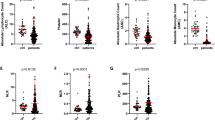Abstract
While abundant data exist documenting variables associated with early platelet engraftment after autologous PBPC transplantation, data concerning later sustained platelet engraftment is sparse. We retrospectively examined a series of 80 patients undergoing autologous PBPC transplantation with respect to their platelet count 6 weeks after transplant. Underlying diagnoses included breast cancer (n = 33), non-Hodgkin’s lymphoma (n = 32), Hodgkin’s disease (n = 9), and other hematologic malignancies (n = 6). Patients received G-CSF for PBPC mobilization and collected a target threshold number of 2.0 × 106 CD34+ cells per kilogram. A univariate analysis revealed that a diagnosis of breast cancer, fewer courses of prior chemotherapy, younger age and complete remission were associated with a higher 6-week platelet count. Additionally, the ability to collect the threshold number of CD34+ with fewer sessions of leukapheresis was also associated with a higher 6-week platelet count. The platelet count and the white blood cell count at the initiation of PBPC collection was also associated with a higher 6-week platelet count. A multivariate analysis revealed a higher platelet count on the first day of pheresis, fewer phereses required to collect 2 × 106 CD34+ cells per kilogram, and a diagnosis of breast cancer were all associated with a higher 6-week post-transplant platelet count. Seven patients failed to reach a 6-week platelet count of 30 × 109/l and an additional five patients had a platelet count of 30–50 × 109/l. We conclude that underlying clinical characteristics, as well as hematologic variables at the time of PBPC collection, influence later, sustained platelet engraftment. A percentage of patients have poor sustained platelet engraftment and may be candidates for new cytokines that specifically target megakaryocyte growth and development.
This is a preview of subscription content, access via your institution
Access options
Subscribe to this journal
Receive 12 print issues and online access
$259.00 per year
only $21.58 per issue
Buy this article
- Purchase on Springer Link
- Instant access to full article PDF
Prices may be subject to local taxes which are calculated during checkout
Similar content being viewed by others
Author information
Authors and Affiliations
Rights and permissions
About this article
Cite this article
Bolwell, B., Goormastic, M., Andresen, S. et al. Variables associated with the platelet count 6 weeks after autologous peripheral blood progenitor cell transplantation. Bone Marrow Transplant 22, 547–551 (1998). https://doi.org/10.1038/sj.bmt.1701378
Received:
Accepted:
Published:
Issue Date:
DOI: https://doi.org/10.1038/sj.bmt.1701378
Keywords
This article is cited by
-
SCT in Jehovah's Witnesses: the bloodless transplant
Bone Marrow Transplantation (2008)



